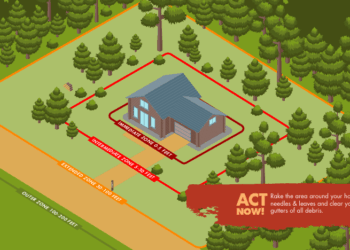By Paul Swenson EBS COLUMNIST

Have you ever noticed driving the canyon between here and Bozeman on a really cold day that there is very little ice on the river by the stoplight on U.S. Highway 191, but as you drive down the canyon ice begins to form along the banks, and on the surface of the river, and gets thicker and thicker as you continue your drive? Or if you drive south from the stop light the river is frozen completely across above the junction all the way up to the 320 Ranch? Then from the 320 to the Yellowstone National Park boundary the river becomes free of ice again, only to be completely frozen over again in the park. What’s the deal?
First, let’s talk about water and some of its unique properties. Water is one of very few liquids that become less dense as it cools, from 39 to 32 degrees Fahrenheit, and expand upon freezing. This property is very important and is due to the bond angles between the hydrogens and oxygen, and from the polarity of the molecule. These properties lead to expansion during the freezing process, which is lucky for us.
Imagine the ocean’s ice during winter were to sink rather than float. The ice would just accumulate at the bottom of the water column to the point where there would be no liquid water left on the Earth. That would be bad for life.
We all learn that ice floats on water. Easy to grasp, just watch ice cubes in a glass of water, or ice flows on a lake, ocean or river. But if you are observant driving along the Gallatin River during very cold mornings, you see ice forming on the riverbed, under inches to feet of water. This ice is called “anchor ice” and can be problematic to our basic understanding of the world, and to the insect, fish, and plant life that depend on a free flow of water.

Anchor ice formation is a fascinating process. It starts with really cold water. So cold in fact the term is “supercooled.” That means the temperature of the liquid is actually below its freezing temperature. When that happens in the river a special type of ice crystal is formed: frazil ice. Frazil ice crystals are small (1-4mm), plate shaped, and suspended throughout the entire water column of the moving river. It is the movement that keeps the crystals from coalescing into a solid sheet of ice. But where the frazil ice encounters objects like the stones in the riverbed, it freezes to them. Then the crystals start to accumulate, making thicker and thicker layers of ice on the bottom of the river—anchor ice.
Sometimes this layer of anchor ice gets thick enough to raise the river level and create floods. Other times it breaks free of the bed and starts a mass of ice flowing down the river which in turn forces more ice to break free, turning the river into an icefloe that can grow quite large. Above the Red Cliff campground for example, you can observe trees next to the river where, last winter, an icefloe stripped the bark off up to 10 feet above river level.
Another formation of frazil ice you see is the “slush” floating on the river after a cold night. If you stop and look at the Gallatin where it passes the pull-off across 191 from the new WIA location there is a lot of slush ice floating in the river. But by the time the river gets down to the highway bridge over the river, all the slush is gone. The reason? The river warms up dramatically over a half mile stretch due to relatively warm water from a large spring system.


The rocks that contain water for these springs were deformed during the formation of the Rocky Mountains. Originally deposited in horizontal layers, here they are tilted to 65 degrees or more. This amount of stress fractures the rock, creating a porous and permeable conduit for ground water. This water enters the rock layers in recharge areas along Levenski Ridge, Tick Ridge, Cinnamon Mountain, Buck Ridge, and a few other places along the Spanish Peak-Gardner fault line.
As the Gallatin River eroded down to its present level it became to lowest point along this aquifer. The flows from these springs keep the river ice-free during the winter and add a little cool water to the summer river flows due to its near constant 50-55 degrees Fahrenheit temperature.
So, the next really cold morning, look for the thick vapor clouds around the springs, the frosty trees, and the differences in the effects of frazil ice that can be observed in the river.













